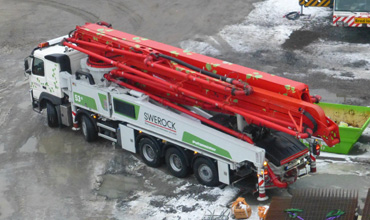
A concrete line pump is a type of equipment used in the construction industry for the transfer of concrete from a mixing truck to the desired location. This pump is equipped with a long, flexible hose that is used to place concrete in hard-to-reach areas, such as high-rise buildings, bridges, and multi-story structures.
The concrete line pump is a versatile and efficient tool that has become increasingly popular in recent years. It has replaced traditional methods of concrete placement, such as wheelbarrows and cranes, as it provides a faster, safer, and more cost-effective solution.
How Does A Concrete Line Pump Works?
The operation of a concrete line pump is relatively straightforward. The pump is attached to a concrete mixing truck, which contains the ready-mixed concrete. The pump draws the concrete from the truck and transfers it through the hose to the desired location. The operator uses a remote control to direct the flow of concrete and ensure that it is placed precisely where it is needed.
Types of Concrete Line Pump
There are several types of concrete line pumps, each designed to meet the specific needs of a construction project. The most common types include trailer-mounted pumps, truck-mounted pumps, and stationary pumps. Trailer-mounted pumps are the most portable option and are ideal for small to medium-sized projects. Truck-mounted pumps are larger and more powerful, making them suitable for larger projects. Stationary pumps are typically used for large, permanent installations and are capable of pumping large volumes of concrete.
Advantages of Concrete Line Pump
0. Another advantage of using a concrete line pump is the improved safety it provides. Concrete line pumps eliminate the need for workers to handle heavy loads of concrete, reducing the risk of injury and making the work site safer for everyone. The pump also eliminates the need for workers to climb ladders or scaffolding to reach high areas, reducing the risk of falls.
0. The concrete line pump also provides greater accuracy and control when placing concrete. The flexible hose allows the operator to reach areas that would otherwise be difficult to access, and the remote control makes it easy to direct the flow of concrete precisely where it is needed. This results in a more efficient and cost-effective placement process, as there is less waste and less need for manual labor.
0. Finally, concrete line pumps are also environmentally friendly. They reduce the need for large concrete trucks, which can cause traffic congestion and increase air pollution. Additionally, the pumps are often equipped with recycling systems that allow for the reuse of concrete washout water, reducing waste and helping to conserve resources.
Final Say
In conclusion, a concrete line pump is an essential tool for the construction industry. It provides a fast, safe, and cost-effective solution for concrete placement and is ideal for a wide range of projects. Whether you are working on a small or large project, a concrete line pump can help you to complete the job efficiently, accurately, and with minimal waste.